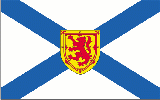|
Nova Scotia
Nova Scotia is one of the three Maritime Provinces located in Eastern Canada. It comprises of a peninsula on the mainland and Cape Breton Island. With an area of 21,345 square miles, including 751 square miles of inland water, it is Canada's second smallest Province. Nova Scotia is situated in the Atlantic Ocean and is almost completely surrounded by water; no part of the province is more than 35 miles from the ocean. The peninsula is joined to the mainland and the Province of New Brunswick by a narrow strip of land called Isthmus of Chignecto. To the North is Prince Edward Island (PEI) and West is Maine, USA. The Province is in the Atlantic Time Zone which is Greenwich Meantime -4 hours. Between the months of April and October Daylight Saving is in effect and the difference is GMT -3 hours. There are hundreds of rivers and small streams; thousands of lakes and many areas of bogs throughout the Province. The Cape Breton Island is home to the highest point of Nova Scotia 532 metres above sea level and is very hilly. The mainland has two ridges that run over 100 miles long. Both the mainland and the Island are an outdoor enthusiasts paradise being rich in recreational opportunities and over 120 Parks to enjoy. There are several areas of the Province that lie below sea level with huge dikes that hold back the sea, allowing for thousands of acres of farmland. Nova Scotia is famous for its many gravel and sand beaches, but the ocean temperatures only allow for swimming during July and August. January is generally the coldest month of the year with an average temperature of -4 degrees celsius near the coast; the hottest month is normally July when the average temperature is 16 degrees Celsius. The interior of the province has colder winters and warmer summers by a few degrees. An average of more than 45 inches of rain falls annually and more than 70 inches of snow covers most of the province in the winter. Ice storms and rain can also happen during the winter. The Provincial Government of Nova Scotia is led by Premier Rodney MacDonald, the leader of the Progressive Conservative party. The past few years have seen the Province turn around its fortunes and have now balanced the budget and are attracting several large IT companies to the halifax area. The Province has an active Immigration Program aiming to attract certain skills and trades - if you meet the qualifying criteria it can make a difference for your application processing time. Not only is the Province trying to attract new Immigrants but also providing Settlement Support Services to give people every chance of making a successful start to their new lives. Other responsibilities of the Provincial Government are the Healthcare System administration which is partially funded by extra cash from the Federal Government. The Provincial Education System is also benefitting from the injection of Federal funds. Both of these issues were election pledges for the Hamm Government. As with all the Provinces, the laws for Driving are set by the Provincial Government. Each Province also has to set its own levels of Income Taxation in addition to the Federal rates - though both are normally collected together the federal rates need to be considered too. These taxes are needed to pay for all the Provincial responsibilities (healthcare, education etc.) - also collected is the Harmonised Sales Tax (HST) which is 13%. This figure includes the Federal GST at 5% though (HST base is 8%). Though you always hope you won't need it, you should familiarise yourself with the regulations about Social Assistance to ensure you know your situation as a newcomer.
|




